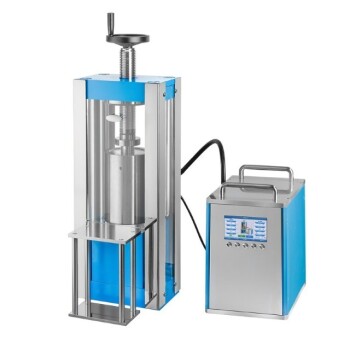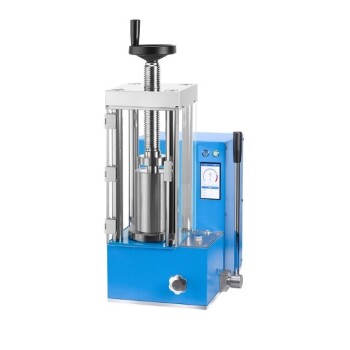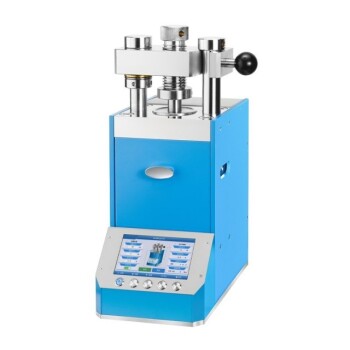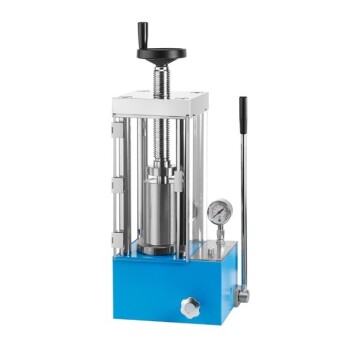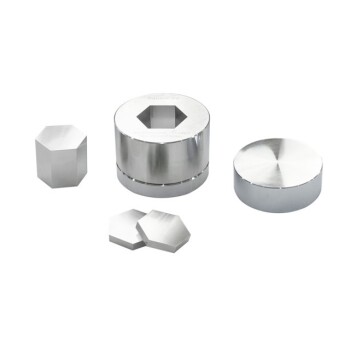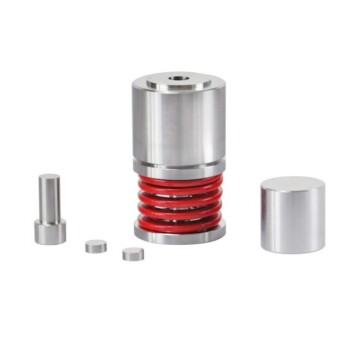At its core, Cold Isostatic Pressing (CIP) is a materials processing method that compacts powders into a solid mass. It achieves this by placing the powder in a sealed, flexible mold, submerging it in a liquid, and applying high, uniform pressure from all directions. This process creates a compacted "green" part with highly consistent density and strength.
The fundamental advantage of CIP is not merely compaction, but the uniformity of that compaction. By leveraging liquid pressure, it bypasses the limitations of traditional pressing, enabling the creation of complex components with consistent material properties throughout.
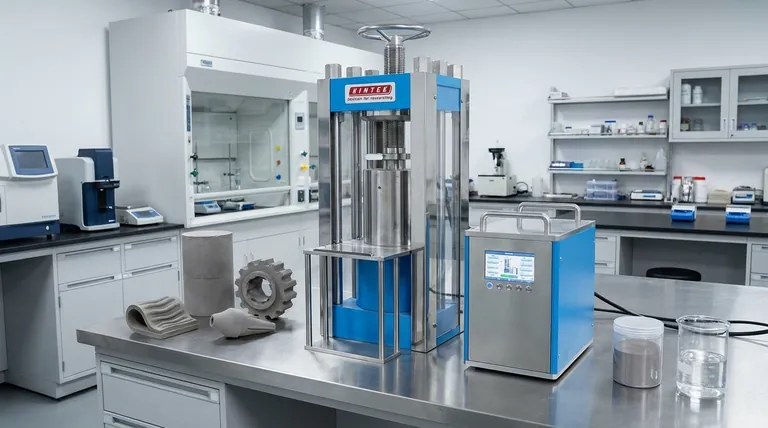
How Cold Isostatic Pressing Works
The effectiveness of CIP is rooted in a fundamental principle of fluid mechanics and is executed through a well-defined sequence of steps.
The Foundation: Pascal's Law
The entire process works because of Pascal's Law. This principle states that pressure applied to an enclosed fluid is transmitted undiminished to every portion of the fluid and the walls of the containing vessel.
In CIP, the liquid (typically water or oil) acts as the medium to transmit pressure perfectly and evenly around the entire surface of the mold.
Step 1: Mold Filling and Sealing
The process begins by filling a flexible mold with the desired powder. This mold, often made of an elastomer like urethane or rubber, defines the shape of the final part. Once filled, the mold is hermetically sealed to prevent the liquid from contaminating the powder.
Step 2: Immersion in the Pressure Vessel
The sealed, powder-filled mold is then placed inside a high-pressure vessel. This vessel is filled with a liquid medium that will be used to apply the pressure.
Step 3: Uniform Pressurization
The vessel is sealed, and high pressure, often ranging from 400 to 1,000 MPa, is applied to the liquid. This pressure is transmitted equally from all directions onto the flexible mold, which collapses and compacts the powder inside it to a high packing density.
Step 4: Depressurization and Extraction
After holding the pressure for a set time, the vessel is depressurized. The compacted part, now referred to as a green part, is removed from the vessel and extracted from the mold. This part has sufficient strength to be handled, machined, or moved to a subsequent sintering process.
The Key Advantages of Isostatic Pressure
Choosing CIP over other compaction methods is a strategic decision based on its unique benefits, particularly when dealing with high-performance materials.
Unmatched Density Uniformity
Traditional uniaxial pressing (pushing from one or two directions) often creates density gradients, where the part is denser near the punch and less dense in the middle. CIP eliminates this issue entirely, resulting in a completely homogeneous part with no internal voids or weak points.
Freedom to Create Complex Geometries
Because the pressure is applied by a flexible mold rather than a rigid die, CIP can produce parts with more complex shapes, undercuts, and hollow sections. This provides significant design freedom for components used in aerospace, medical, and automotive applications.
Enhanced Green Strength
The uniform compaction results in a green part with superior strength compared to other methods. This robustness minimizes the risk of cracking or damage during handling before the final sintering or heat treatment stage, which locks in the final material properties.
Understanding the Trade-offs
While powerful, CIP is not the universal solution for all powder compaction needs. Understanding its limitations is critical for proper application.
Slower Cycle Times
Compared to the high-speed, automated nature of uniaxial pressing, CIP can be a slower, more batch-oriented process. This is especially true for the "wet-bag" method where molds are manually loaded and unloaded for each cycle.
Tooling and Consumables
The flexible elastomer molds are considered a consumable part of the process. They have a finite lifespan and will wear out or tear over time, requiring replacement and adding to the operational cost.
Dimensional Tolerances
CIP produces excellent "near-net shapes," but it may not achieve the final, tight dimensional tolerances required for some applications without secondary processing. The final part often requires machining or sintering to meet precise specifications.
Making the Right Choice for Your Application
Selecting the correct compaction method depends entirely on the priorities of your project, balancing cost, complexity, and performance requirements.
- If your primary focus is high-volume production of simple shapes: Traditional uniaxial pressing is likely more cost-effective due to its higher speed and automation potential.
- If your primary focus is creating complex parts with uniform material properties: CIP is an ideal choice, especially for critical, high-performance components where internal flaws are unacceptable.
- If your primary focus is producing large, dense billets for subsequent machining: CIP excels at creating large, homogeneous blocks of material with minimal internal defects, providing a perfect starting point for subtractive manufacturing.
Ultimately, understanding Cold Isostatic Pressing empowers you to select a manufacturing path that guarantees the structural integrity your component demands.
Summary Table:
| Aspect | Details |
|---|---|
| Process | Compacts powders using fluid pressure in a flexible mold for uniform density. |
| Key Principle | Pascal's Law ensures pressure is transmitted equally in all directions. |
| Pressure Range | Typically 400 to 1,000 MPa. |
| Main Advantages | Uniform density, ability to create complex geometries, enhanced green strength. |
| Common Applications | Aerospace, medical devices, automotive components, and large billets. |
| Limitations | Slower cycle times, consumable molds, may require secondary processing for tight tolerances. |
Ready to enhance your laboratory's capabilities with precise powder compaction? KINTEK specializes in lab press machines, including automatic lab presses, isostatic presses, and heated lab presses, designed to meet the needs of research and development labs. Our solutions deliver uniform density and complex part formation, ensuring high-quality results for your critical applications. Contact us today to discuss how our equipment can optimize your processes and drive innovation in your projects!
Visual Guide

Related Products
- Electric Split Lab Cold Isostatic Pressing CIP Machine
- Electric Lab Cold Isostatic Press CIP Machine
- Automatic Lab Cold Isostatic Pressing CIP Machine
- Manual Cold Isostatic Pressing CIP Machine Pellet Press
- Automatic Laboratory Hydraulic Press Lab Pellet Press Machine
People Also Ask
- How does electrical Cold Isostatic Pressing (CIP) contribute to cost savings? Unlock Efficiency and Reduce Expenses
- What are the common forming processes in advanced ceramics? Optimize Your Manufacturing for Better Results
- What are the advantages of Cold Isostatic Pressing (CIP) for pellet preparation? Achieve Superior Density and Uniformity
- What are some specific aerospace applications of isostatic pressing? Enhance Performance and Reliability in Extreme Conditions
- What is Cold Isostatic Pressing (CIP) used for? Achieve Uniform Density in Complex Parts
